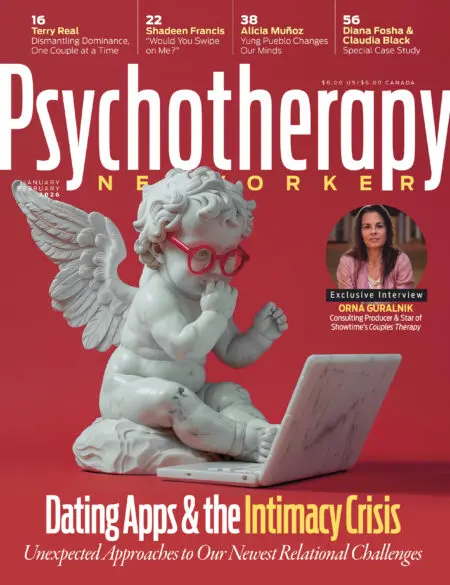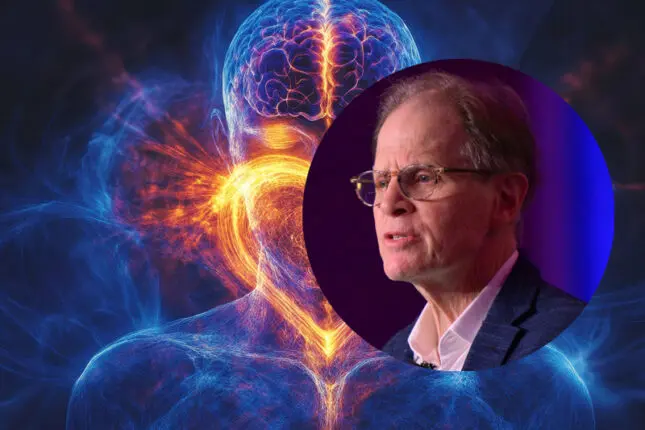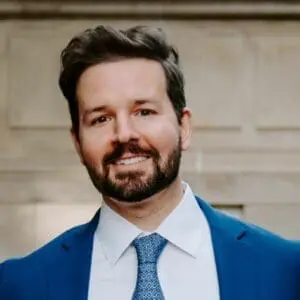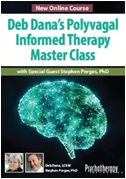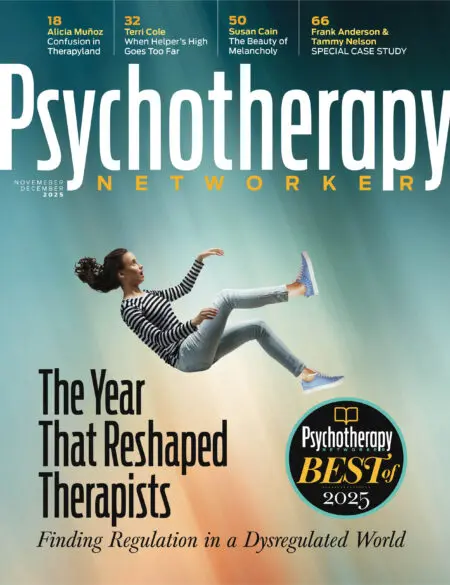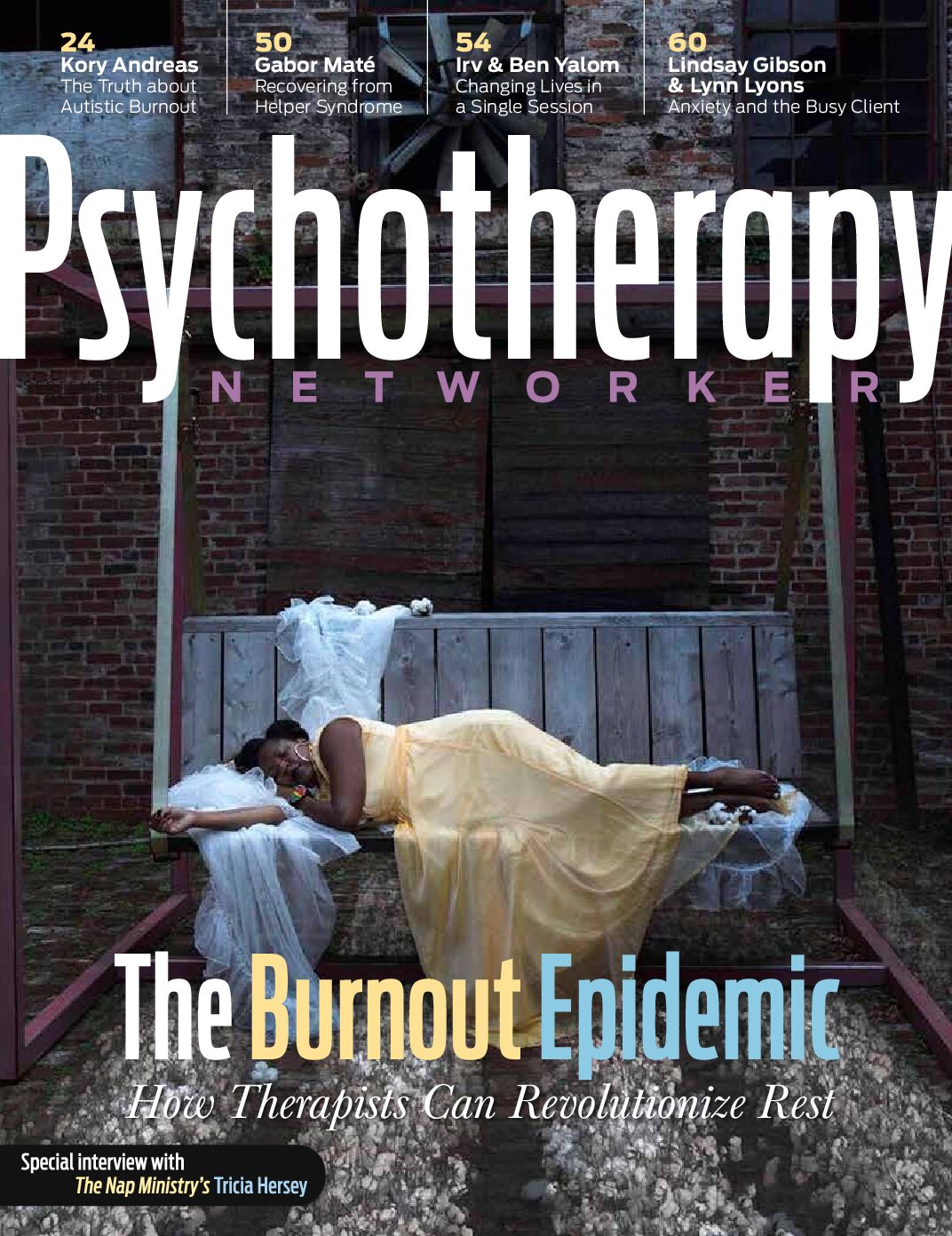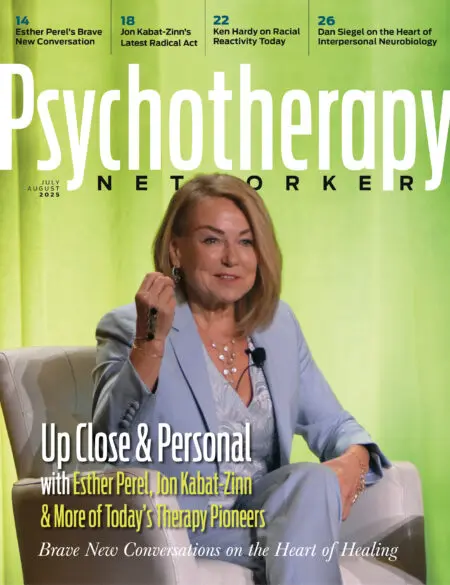Enjoy the audio version of this article—perfect for listening on the go.
The words interpersonal neurobiology don’t exactly roll off the tongue—and for most people, they’re even harder to parse. So it’s only natural you’re feeling some trepidation as you prepare to watch Dan Siegel’s recent Symposium workshop, “Temperament, Attachment, and Personality: Individual Development through the Lens of Interpersonal Neurobiology.” Maybe you’re wondering whether this brainy-sounding training is yet another attempt to scientize the beautiful, heart-centered, and often nebulous work of therapy. You wouldn’t be wrong, but you also wouldn’t be right.
Sure, Siegel is a Harvard-trained psychiatrist, a former clinical professor of psychiatry at UCLA’s School of Medicine, and the author of books like Brainstorm, The Developing Mind, The Yes Brain, and The Whole-Brain Child. But before you think you’ve got him figured out, just give this workshop a few minutes. Chances are you’ll be surprised.
“I’d like this experience to be as immersive as possible,” he tells the audience moments after walking onstage. “I want the material to be something you feel into, not just think about. We’ll be doing some things that aren’t my usual. We’ll be going on a journey.” Intrigued yet?
There’s a reason why Symposium staff refer to Siegel as “The Keynote Machine.” He’s undeniably brilliant and accomplished (after all, he’s written five New York Times bestsellers), but he isn’t slick, stiff, or pontificating. And he isn’t squirrely or neurotic the way you might expect from someone of his intellectual stature. Rather, he’s warm, gentle, and unassuming. He speaks slowly and intentionally, as if channeling the spirit of Fred Rogers—with a hint of Bill Nye the Science Guy. As comedian Chelsea Handler—who personally chose Siegel to be her therapist—will attest, he can also be deceptively witty.
“If you were born into a body, then you have a nervous system,” he says. “And that shouldn’t make you nervous! Now if you’ll reach under your chair,” he instructs, “you’ll find a take-home model of the brain. Reach down and pull your hand out,” he says, making a fist, “and you’ll find attached to your wrist is … a hand! This is your own model of the brain.” The audience laughs, and Siegel proceeds to break down the different parts of his fist-brain, including the top part, the limbic area. “This is the part that’s always learning, learning, learning,” he says. “And if I do my job right today, hopefully this part of your brain will grow.”
The Ghost in the Machine
As the workshop continues, Siegel walks through temperament (“a feature of a child present at birth, not learned through experience”) and personality (“enduring patterns of emotion, thought, and behavior that persist across all situations and stages of life”). But just as you start to wonder what any of this has to do with therapy, the revelation comes: when you understand the machinery under the hood, Siegel says—the things that science can explain—you get a little bit closer to understanding the things it can’t, like the invisible, connective energy that exists between lovers, friends, or family, or between a therapist and client in a moment of shared discovery. This connection, Siegel says, is the interpersonal half of interpersonal neurobiology—and a function of the mind.
It’s here that the essence of Siegel’s workshop begins to come into focus—and it’s also where he diverges from the scientific establishment. “For more than 30 years, I’ve been trying to translate the science for clinical application,” he says, “but also explain that the mind is not just the brain.” This was especially controversial during the ’90s, known as “The Decade of the Brain” and the heyday of the pharmaceutical industry, and he was chided by many colleagues who insisted that “relationships don’t matter unless we’re talking about the genes.” But Siegel was, and remains, undeterred. “It’s an error to say the mind is a synonym for brain activity alone,” he says. “So hopefully you realize that as therapists, you’re specialists in both the embodied and relational mind.”
Whether you call it rapport or the therapeutic alliance or something else, this invisible force that materializes between the therapist and client—perhaps the most vital element in successful therapy—can’t really be explained or measured. And therein lies the problem: 25 years after The Decade of the Brain, our field still puts a premium on processes that can be objectively measured. Manuals, diagnoses, and evidence-based treatments certainly have their place, but have we assigned them too much value? And if so, at what cost? Even if you believe the key to healing is something elemental and mysterious—a function of the mind, as Siegel contends—would you openly admit this to your clients and colleagues? Or would you hold your tongue to maintain the appearance of “credibility”? This is what makes Seigel such an excellent advocate for this invisible force: he can sway the naysayers with a little science—and once they’re listening, guide them toward the heart of healing.
Thirty minutes into the workshop, Siegel begins to make this pivot. As he’s breaking down human development—the meeting of the sperm and the egg—his voice softens and slows. “Two halves become one,” he says. “Just feel into that. Two halves become one. Of all the many sperm and all the many eggs, that’s a miracle. Of all the infinite possible combinations,” he continues, extending a cupped hand toward the audience, “something happened from this vast sea of possibility, which is you. You are … a sacred being.”
The tone in the room is different now. Some audience members nod their heads; others give a knowing Mmmm—in that way that therapists often do. Siegel continues. “This miracle that is you—and I don’t want to shock anyone with this one—gets about a century to live.” You start to wonder where Siegel is heading with this, and then his voice begins to crack.
“Twelve weeks ago, when the fires were erupting in Los Angeles, my mom had to be evacuated from her assisted living home,” he announces. “The air was terrible, and two days later, she died from a lung complication at age 95. She died peacefully, surrounded by everyone she loved: her kids, her grandkids, and her two dogs. She had a smile on her face before she passed away,” he continues, “and as she looked at us, her last words were, ‘You’ve all been so wonderful.’”
It’s an unexpected, bittersweet disclosure. Several audience members let out audible, empathic sighs. But Siegel keeps moving. He shares how he recently attended a friend’s memorial service, where he heard a song that not only made him think of his mother, but lingered with him long afterward.
“My growth edge is to try to do things that are new and uncertain and filled with fear, so now I’m going to sing it to you,” Siegel announces, raising a finger. “Actually, I’m going to teach you the chorus, and we can sing it together.” More than a few audience members exchange sidelong glances. After all, this is a conference workshop. Singing feels a little out of place. And what does a song have to do with therapy, anyway?
The Measure
This song, Siegel tells the audience, is called “The Measure,” by Bob Sima. “Not only is it amazing,” he says, “but it’s totally relevant to what we’re learning about today. Mom got about a century to live, and many of us will get even less. So what are you going to do with it? With this wild and precious life? That’s what this song is about.”
Siegel takes the microphone with both hands. “Inside this body called Dan, I’m incredibly anxious,” he confesses. “I have no training as a singer. I can’t sing on pitch, and I’ve never sung in public—not even in front of my family. I make sure the door is closed and the shower’s running. But I’m going to sing this with you.” He closes his eyes, takes a deep breath, shakes out his shoulders, and begins:
Tell me what is the measure
Of a life well done?
Tell me how do you count
An uncountable song?
A collection of your minutes,
Your hours and your days,
The number of heartbeats, breaths,
And the lines on your face.
Siegel keeps going, pinching his thumb and forefinger together to accentuate the final notes. The audience is silent, seemingly moved and entranced. Then, he pauses.
“You know, at the end of life you have nothing more to give because your body has given out, and you have nothing left to receive, and the symbol of that is your empty hands. So here’s the chorus.”
When your hands are empty
And your heart is full,
And you can smile on your very last day,
There is nothing you need to measure
And nothing you need to say
And nothing to take with you
But what you have given away.
Siegel repeats the chorus—a bit slower this time—and invites the audience to join him. The sound fills the room, gentle and melodic. The notes are a little sharper now, refining Siegel’s tune, and his face lights up with a smile as he lets the audience carry the rest of the chorus alone. Suddenly, you realize what’s happening. Between their rapt attention and Siegel’s nerves fading into a smile, brains are stirring. Pleasure and learning centers are lighting up, secreting cortisol, then endorphins, then serotonin and dopamine. But something else is happening too, a timeless and beautiful call and response that humans have been performing since the dawn of civilization. This, you realize, is what Siegel was talking about all along: this is the invisible force, it’s connection in real time.
Siegel shifts to another verse:
In the final-hour curtain call,
Did you sing the song you came to sing?
It’s the thoughts and the words and the actions you choose.
It’s paying it forward and speaking your truth.
It’s a call to love a little deeper, and kiss just a little bit sweeter.
Then, with just a sweep of Siegel’s hand, the audience sings the chorus once more before Siegel sings the final verse:
You’re an accumulation of the lives that you touch.
You’re a celebration of the wind and the dust.
You were put here for a reason.
Be of service and be a beacon.
“Was that okay?” he asks.
The audience erupts into applause, and Siegel brings a hand to his heart. “Thank you for singing that with me,” he says. “That song plays in my head every day. It’s about getting interpersonal neurobiology out into the world,” he explains. “We’re relational beings, and in our work as therapists, if we can help our clients—and our inner selves, too—achieve what Bob Sima is saying, then we can smile, like my mom did, on our very last day. We’re all going to die one day, so why not die with dignity? That’s what we’re trying to help people do.”
Truth, Inside and Out
Several weeks after his Symposium workshop, Siegel is still metabolizing things. Not just what unfolded that afternoon, but the confluence of it all: his mother’s passing, his life and work, the role of therapists, the gifts and limitations of science, the mysterious energy that connects us all, and the song that helped him put his thoughts and feelings and call to action into words. “My work has always been about trying to seek truth,” he says, “and that song is full of truth.”
A scientist with a poet’s heart, who’s unafraid to muse on the mysteries of the mind and human connection, Siegel’s internal compass has always seemed to point toward the truth. But even now, he seems to be working toward a truer version of himself, a version that thinks and acts more intentionally about what it means to live a life fully and well. He confesses that his decision to sing “The Measure” wasn’t always part of his agenda, but the night before the workshop, he had an epiphany.
“I realized I should walk the talk and show what a growth edge looks like,” he says. “Sometimes as a professional, you feel like you’re supposed to take a neutral, objective, professional stance. I certainly know how to do that, being trained as a scientist, and I can teach that way too. But I think we need to be more than that. When I got onstage, I didn’t just want to be present as an intellectual. I wanted to be present as a person.”
For now, some truths, like the intangible connections that unfold in therapists’ offices, or on hospital beds, or in conference rooms, will remain a mystery. And it’s just as likely that the field will continue to chase interventions that can be measured and proven with numbers and data. But just because something can’t be seen under a microscope—like the wetness of water, Siegel says—doesn’t mean it’s not there. That energy is a very real, scientific thing, he explains. “It’s the feeling of being alive.”
Chris Lyford
Chris Lyford is the Senior Editor at Psychotherapy Networker. Previously, he was assistant director and editor of the The Atlantic Post, where he wrote and edited news pieces on the Middle East and Africa. He also formerly worked at The Washington Post, where he wrote local feature pieces for the Metro, Sports, and Style sections. Contact: clyford@psychnetworker.org.
